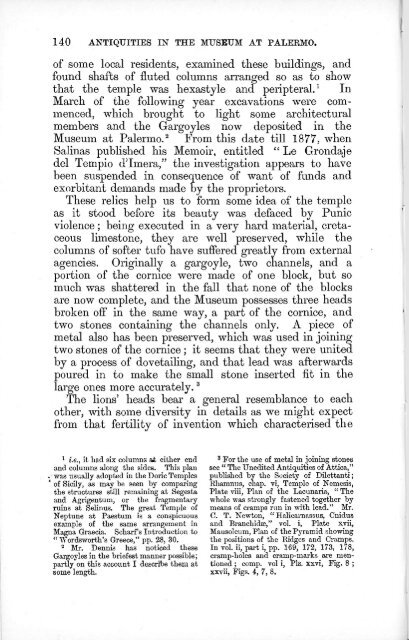Sicily presents to the ordinary tourist attractions which in number ...
Sicily presents to the ordinary tourist attractions which in number ...
Sicily presents to the ordinary tourist attractions which in number ...
Create successful ePaper yourself
Turn your PDF publications into a flip-book with our unique Google optimized e-Paper software.
140 ANTIQUITIES IN THE MUSEUM AT PALERMO.<br />
of some local residents, exam<strong>in</strong>ed <strong>the</strong>se build<strong>in</strong>gs, and<br />
found shafts of fluted columns arranged so as <strong>to</strong> show<br />
that <strong>the</strong> temple was hexastyle and peripteral. 1 In<br />
March of <strong>the</strong> follow<strong>in</strong>g year excavations were commenced,<br />
<strong>which</strong> brought <strong>to</strong> light some architectural<br />
members and <strong>the</strong> Gargoyles now deposited <strong>in</strong> <strong>the</strong><br />
Museum at Palermo. 2 From this date till 1877, when<br />
Sal<strong>in</strong>as published his Memoir, entitled " Le Grondaje<br />
del Tempio d'lmera," <strong>the</strong> <strong>in</strong>vestigation appears <strong>to</strong> have<br />
been suspended <strong>in</strong> consequence of want of funds and<br />
exorbitant demands made by <strong>the</strong> proprie<strong>to</strong>rs.<br />
These relics help us <strong>to</strong> form some idea of <strong>the</strong> temple<br />
as it s<strong>to</strong>od before its beauty was defaced by Punic<br />
violence; be<strong>in</strong>g executed <strong>in</strong> a very hard material, cretaceous<br />
limes<strong>to</strong>ne, <strong>the</strong>y are well preserved, while <strong>the</strong><br />
columns of softer tufo have suffered greatly from external<br />
agencies. Orig<strong>in</strong>ally a gargoyle, two channels, and a<br />
portion of <strong>the</strong> cornice were made of one block, but so<br />
much was shattered <strong>in</strong> <strong>the</strong> fall that none of <strong>the</strong> blocks<br />
are now complete, and <strong>the</strong> Museum possesses three heads<br />
broken off <strong>in</strong> <strong>the</strong> same way, a part of <strong>the</strong> cornice, and<br />
two s<strong>to</strong>nes conta<strong>in</strong><strong>in</strong>g <strong>the</strong> channels only. A piece of<br />
metal also has been preserved, <strong>which</strong> was used <strong>in</strong> jo<strong>in</strong><strong>in</strong>g<br />
two s<strong>to</strong>nes of <strong>the</strong> cornice ; it seems that <strong>the</strong>y were united<br />
by a process of dovetail<strong>in</strong>g, and that lead was afterwards<br />
poured <strong>in</strong> <strong>to</strong> make <strong>the</strong> small s<strong>to</strong>ne <strong>in</strong>serted fit <strong>in</strong> <strong>the</strong><br />
large ones more accurately. 3<br />
The lions' heads bear a general resemblance <strong>to</strong> each<br />
o<strong>the</strong>r, with some diversity <strong>in</strong> details as we might expect<br />
from that fertility of <strong>in</strong>vention <strong>which</strong> characterised <strong>the</strong><br />
1 i.e., it had six columns at ei<strong>the</strong>r end<br />
and columns along <strong>the</strong> sides. This plan<br />
- was usually adopted <strong>in</strong> <strong>the</strong> Doric Temples<br />
* of <strong>Sicily</strong>, as may be seen by compar<strong>in</strong>g<br />
<strong>the</strong> structures still rema<strong>in</strong><strong>in</strong>g at Segesta<br />
and Agrigentum, or <strong>the</strong> fragmentary<br />
ru<strong>in</strong>s at Sel<strong>in</strong>us. The great Temple of<br />
Neptune at Paestum is a conspicuous<br />
example of <strong>the</strong> same arrangement <strong>in</strong><br />
Magna Graecia. Scharf's Introduction <strong>to</strong><br />
" Wordsworth's Greece," pp. 28, 30.<br />
2 Mr. Dennis has noticed <strong>the</strong>se<br />
Gargoyles <strong>in</strong> <strong>the</strong> briefest manner possible;<br />
partly on this account I describe <strong>the</strong>m at<br />
some length.<br />
3 For <strong>the</strong> use of metal <strong>in</strong> jo<strong>in</strong><strong>in</strong>g s<strong>to</strong>nes<br />
see " The Unedited Antiquities of Attica,"<br />
published by <strong>the</strong> Society of Dilettanti;<br />
Rhamnus, chap, vi, Temple of Nemesis,<br />
Plate viii, Plan of <strong>the</strong> Lacunaria, " The<br />
whole was strongly fastened <strong>to</strong>ge<strong>the</strong>r by<br />
means of cramps run <strong>in</strong> with lead." Mr.<br />
C. T. New<strong>to</strong>n, " Halicarnassus, Cnidus<br />
and Branchidie," vol. i, Plate xvii,<br />
Mausoleum, Plan of <strong>the</strong> Pyramid show<strong>in</strong>g<br />
<strong>the</strong> positions of <strong>the</strong> Ridges and Cramps.<br />
In vol. ii, part i, pp. 169, 172, 173, 178,<br />
cramp-holes and cramp-marks are mentioned<br />
; comp. vol i, Pis. xxvi, Fig. 8 ;<br />
xxvii, Figs. 4, 7, 8.

















